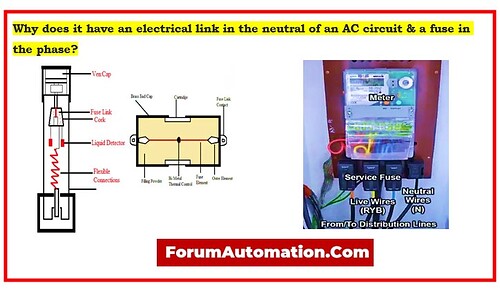The two terms “neutral” and “phase” relate to different components of the electrical system when used in a setting of an AC circuit. A conductor that allows the electric current in an alternating current circuit a way to go back to its source is called the neutral wire. Typically, it will be linked to the neutral terminal point of a source of power, including a generator or a transformer. The voltage on the neutral line is maintained at or very near to ground potential, & its potential difference is very low.
On the other end, the phase wire is the one that conducts the alternating current and is the one that is responsible for supplying power to the various electrical loads. This wire is also referred to as the “hot” wire. In order to achieve the desired direction of the flow of electrical energy, the voltage of the phase wire will cycle between positive & negative values.
Now, with regard to the inclusion of a link (also known as a “link wire”) & a fuse in the circuit, their respective functions are as follows:
1). Link wire:
At a certain point in the circuit, the neutral wire and the phase wire are joined together by means of a link wire, which is typically a conductor that is of a shorter length. Typically, this connection will be established at the primary distribution panel or one of the subpanels. The function of the link wire is to facilitate the flow of current from the electrical loads back to the electrical source via the neutral wire. This is accomplished by providing a pathway for the current. It is essential to the effective operation of the electrical network that the circuit loop be completed by this component.
2). Fuse:
A fuse is a kind of safety device utilised in electrical circuits. Its purpose is to limit the amount of electricity that may pass through the circuit. In most condition, it will be connected to the phase wire that the circuit possesses. A thin wire (or) strip of a substance that, when subjected to an excessive current, would melt is contained inside the fuse. When the current flows through the fuse at a rate that is higher than its rating, the wire melts, which breaks the circuit and stops any further current flow. This serves to safeguard the circuit as well as the devices that are connected from harm that might be caused by excessive current (or) short circuits.
In conclusion, the link wire is that used to connect the phase wire to the neutral wire in order to complete and close off the circuit loop, and the fuse is that is inserted into the phase wire in order to protect the circuit from an excessive amount of current.
